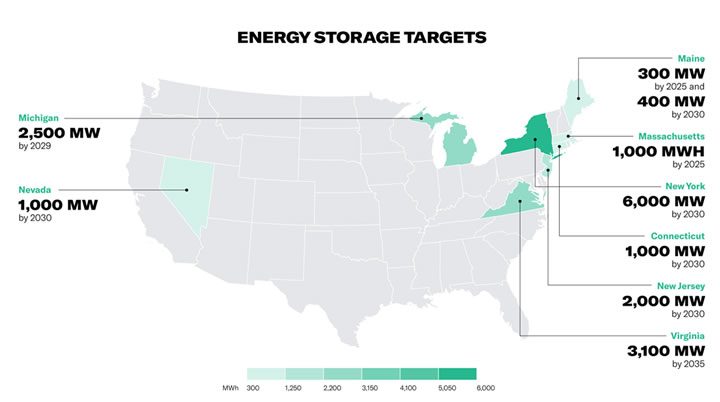Powin surveyed 1,000 American consumers 18 or older to discover how prepared they are for the next generation of energy consumption and their preference for addressing rising demand.
 America’s Energy Awakening: Why Consumers Are Ready to Power the Future with Renewables and Storage
America’s Energy Awakening: Why Consumers Are Ready to Power the Future with Renewables and Storage

Report from | Powin
The energy landscape is changing fast, and at Powin, we wanted to better understand how the average American is preparing for their future energy needs. Countless reports have determined that energy demand is skyrocketing due to data center usage which is exacerbated by AI, more electric vehicles on the road, and home electrification. In short, the power grid needs more support to meet the energy needs of the 21st century.
To that end, Powin surveyed 1,000 American consumers 18 or older to discover how prepared they are for the next generation of energy consumption and their preference for addressing rising demand. From our findings, it’s clear that not only are utility-scale solar and storage crucial to support the ongoing energy transition, but consumers are also jumping on board.
To meet increased energy demand, Americans are hungry for clean energy projects
After remaining relatively flat for several years, projected new energy demand doubled in 2023. Some companies have called for the construction of more natural gas plants to meet this rising demand. However, our survey found that consumers would prefer the construction of renewable energy plants plus battery storage to meet demand.
- Two-thirds (66%) of respondents would prefer to see solar farms built to cope with increased energy demand, which was the number one response, as opposed to only thirty-eight percent for natural gas and thirteen percent for coal plants.
- When asked if they’re concerned about the United States’ ability to meet net-zero targets given the rising demand for energy, over half (58%) responded Yes compared with only one-quarter (25%) who responded No.
- Nearly half (48%) of respondents believe solar farms, when paired with big batteries to store energy for later, are as reliable as fossil fuel power plants. Only one-quarter (25%) do not believe solar plus storage is as reliable.
- Two-thirds (66%) of respondents would support their electricity company building big solar power plants and battery storage systems instead of building more fossil fuel plants, compared to only fourteen percent who would not support.

A Cheaper and Cleaner Path Forward
The public is calling for cleaner energy sources, and as demand soars, renewables are stepping up to the plate. With faster deployment, lower maintenance costs, and minimal environmental impact, renewables are the obvious choice. Not only are they easier and quicker to implement, but they also come with a significantly lower price tag. In 2022, the average cost of electricity from solar PV was just $0.049 per kilowatt-hour (kWh), nearly a third less than the cheapest fossil fuel. Onshore wind was even more economical, at $0.033 per kWh, which is less than half the price of the cheapest fossil fuel option, according to the International Renewable Energy Agency (IRENA). This cost advantage is a game-changer, helping renewables power 30% of global electricity demand in 2023. And this is just the beginning—the future of energy is greener, cleaner, and more affordable than ever.
Harnessing the Power Renewables with Energy Storage
As we ramp up the use of renewables, new challenges emerge for our utility grid. To keep operations safe and reliable, pairing energy storage with renewables is crucial. This combination not only prevents power wastage but also ensures grid stability by delivering essential ancillary services for optimal performance, including fast-responding frequency regulation, voltage support, capacity firming, spinning reserves, etc. Recognizing this, many states have mandated that utilities include energy storage in their Integrated Resource Plans (IRPs) or have set specific storage targets. Here’s a list of states leading the charge with energy storage mandates or targets:

When it Comes to Energy, Americans Are Left in the Dark
Although people are in favor of expanding renewables, our survey also found that many Americans are generally unaware that energy demand is rising, that their own energy usage has changed.
- Only thirty-eight percent of respondents know how much energy their residence consumes on a monthly basis.
- While nearly half of respondents (44%) claim their residence does not need more energy today than five years ago, the lack of knowledge around overall consumption suggests that the average consumer is not actually aware of how their usage has changed.

This disconnect extends to the reasons behind rising energy prices, particularly when rate hikes are necessary to build new infrastructure or power plants. This gap in understanding could pose a significant challenge as we rethink our entire energy system, which will require substantial upfront investment. Bridging this knowledge gap is crucial for gaining public support for the necessary changes and ensuring a smooth transition to a more sustainable and reliable energy future.
Regardless, the People Have Spoken: Renewables Are Here to Stay
The people have spoken—renewables are here to stay, and energy storage is the key enabler. According to our data, Americans are eager for more renewable energy. As leaders in the climate tech business, it's our job to provide the technology that makes this possible. By advancing energy storage solutions, we can deliver power in an affordable and reliable way, ensuring a sustainable energy future for all. Let's rise to the challenge and make renewable energy the cornerstone of our grid.
The content & opinions in this article are the author’s and do not necessarily represent the views of AltEnergyMag
Comments (0)
This post does not have any comments. Be the first to leave a comment below.
Featured Product

